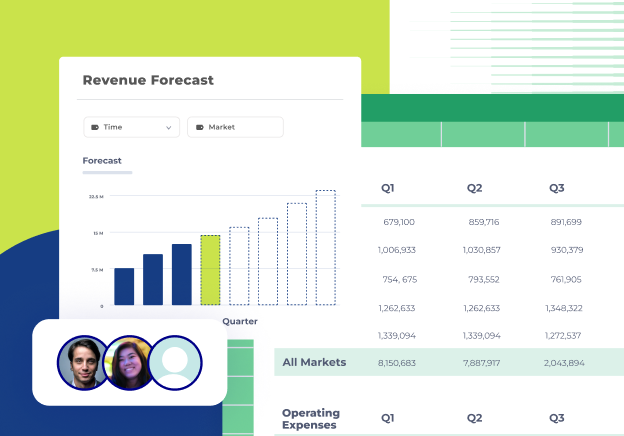Product

Solutions

resources

Company

Congrats on your score!
Your FP&A is Foundational.
FP&A is a core function in your organization, but there’s still some work to be done to connect it to your broader organizational strategy. At this level, you're laying the groundwork for more advanced financial practices. Keep reading for more insights on where to go from here.
Grow your FP&A prowess
There's work to be done, but you've got this!
Aligning FP&A with your company's strategic objectives requires understanding the strategic vision, standardizing planning processes through governance and centralized data sources, structuring data effectively, and leveraging modern FP&A software to help you scale.
Connect to strategy
Have a clear understanding of your company's strategic vision, objectives, and key priorities. This involves collaborating closely with leadership to gain insights into the long-term vision and targets.
Standardize your planning process
Standardize your FP&A process: define each step, use standard templates and centralized data sources, implement SOPs and centralized planning software, and create a governance framework.
Structure your data
Implement governance, prioritize critical datasets, and foster cross-functional collaboration on standards. Leverage modern FP&A software to ensure high-quality, consistent data that improves planning and decision-making.
Where are you on the path to strategic finance mastery?
1
Foundational
Laying groundwork
- Not yet fully aligned with the broader strategic goals of your company
- Work to be done to standardize the planning process outside of the annual budget
- Basic financial model and reporting
- Operating with unstructured data and no formal model or static model
2
Developing
Iterative improvements
- Finance part of decision-informing processes at a broader level
- Annual planning process (not clearly defined) but with occasional reporting to stakeholders
- Non-value-added tasks are automated. Starting to implement basic best practices, along with an annual planning process
- Leveraging a partially driver-based model
3
Defined
Holistic FP&A
- Finance provides critical insights and analysis that drive decision-making
- Defined planning process with regular reporting cadence and communication with stakeholders
- Clearly defined reporting, planning and performance management, and company-wide collaboration
- Fully driver-based model
4
Refined
Optimized XP&A
- Finance is fully connected to the strategy, and drives innovation, helping to shape strategic direction
- The annual planning process is defined where owners can drive updates and changes to/from finance independently with approvals
- Standardized performance management that reduces cost, improves speed, accuracy, and transparency of forecasts and reporting
- Leveraging a fully driver-based model with automation from users and systems
5
Masterful
XP&A mastery
- Finance is a key driver of change and is recognized as a strategic partner at the highest levels of the business
- Predictive / statistical forecasting is combined with performance management and iterative planning, replanning, reporting, analytics, and reforecasting
- Fully driver-based and in real-time
The guiding principles of strategic finance
Foresight
The proactive anticipation of future financial trends and challenges, enable companies to make informed decisions and strategic plans. This principle emphasizes the use of data analytics, scenario planning, and forecasting techniques to predict potential outcomes and mitigate risks.
Alignment
Financial strategies and goals should closely align with your business objectives and operational plans. Strategic leaders foster collaboration across departments, ensuring everyone works towards a common mission.
Storytelling
Storytelling in FP&A transforms complex financial data and analyses into compelling narratives that stakeholders can easily understand and act upon. Effective storytelling bridges the gap between financial experts and non-financial stakeholders, facilitating better decision-making.
Balance
FP&A involves managing the trade-offs between short-term financial performance and long-term strategic goals. Careful evaluation of risks and opportunities is a heavy weight on a finance leader’s shoulders. By striving for balance, organizations can navigate financial complexities while achieving both immediate and future objectives.
Learn from finance professionals just like you
“I think being a human in finance is a sometimes forgotten skill.”
Julia Coto
CFO, Chartspan Medical Technologies
“We have high standards of what we look for. It comes down to three characteristics: hungry, humble, and smart.”
Dustin Walsted
VP of Finance, Tech, Strategy & HR, Smart City Apartment Locating
“You need to take your coworkers on the journey with you.”
Bryan Szwarz
Senior Manager of FP&A, Clearly Canadian
“I think being a human in finance is a sometimes forgotten skill.”
Julia Coto
CFO, Chartspan Medical Technologies
“We have high standards of what we look for. It comes down to three characteristics: hungry, humble, and smart.”
Dustin Walsted
VP of Finance, Tech, Strategy & HR, Smart City Apartment Locating
“You need to take your coworkers on the journey with you.”
Bryan Szwarz
Senior Manager of FP&A, Clearly Canadian
Bookmark these FP&A
and finance resources

Templates, Budgeting & Forecasting
The All-in-One Financial Planning Calendar
Discover how to create an effective financial planning calendar, plus tips and tricks for improving your planning process and collaboration.
Read more

Professional development
Learn FP&A: The 15 Best FP&A Certifications and Courses [2024]
Learn FP&A with some of the best FP&A courses and certifications of 2024.
Read more

Budgeting & Forecasting
How to accelerate your annual budgeting process (in 2024)
Many businesses dread the annual budgeting process as the fiscal year comes to a close. However, here are some tips for speeding it up.
Read more


.png)









.png)